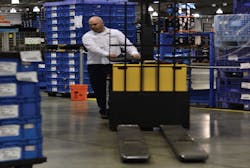National Forklift Safety Day: Encouraging Safe Behavior Around Powered Industrial Trucks
In 2011, according to the 2014 edition of Injury Facts from the National Safety Council, 66 workers died as a result of operating or worker near a forklift. A forklift was a secondary source of fatal injuries for an additional 24 workers. Those numbers are up from 2010, in which forklifts were a primary source of fatal injury for 54 workers and a secondary source of fatal injury for 31 workers.
National Forklift Safety Day, which is scheduled for June 10 in Washington, D.C., will serve as a focal point for manufacturers to highlight the safe use of forklifts and importance of operator training to reduce fatalities and injuries related to the use of forklifts. Sponsored by the Industrial Truck Association, the day provides an opportunity for the industry to educate customers, policymakers and the administration on forklift operating safety practices and events on June 9 and 10 will allow customers and manufacturers the opportunity to network.
What Are Powered Industrial Trucks?
Powered industrial trucks, commonly called forklifts or lift trucks, are used in many industries, primarily to move materials. They can also be used to raise, lower or remove large objects or a number of smaller objects on pallets or in boxes, crates or other containers. Powered industrial trucks either can be ridden by the operator or controlled by a walking operator.
There are many types of powered industrial trucks. Each type presents different operating hazards. For example, a sit-down, counterbalanced high-lift rider truck is more likely than a motorized hand truck to be involved in a falling load accident because the sit-down rider truck can lift a load much higher than a hand truck.
Workplace type and conditions also are factors in hazards commonly associated with powered industrial trucks. For example, retail establishments often face greater challenges than other worksites in maintaining pedestrian safety. Beyond that, many workers can also be injured when (1) lift trucks inadvertently are driven off loading docks; (2) lifts fall between docks and an unsecured trailer; (3) they are struck by a lift truck; or (4) they fall while on elevated pallets and tines.
OSHA enforces regulations regarding the manufacture and operation of industrial trucks. The Industrial Truck Standards Development Foundation (ITSDF), which is accredited by ANSI, and UL (Underwriters Laboratories Inc.) develop the safety standards for designing and manufacturing industrial trucks. National Forklift Safety Day will provide greater awareness of regulations and safe practices to encourage safer behavior.
Preventing Forklift Accidents
Determining the best way to protect workers from injury largely depends on the type of truck operated and the worksite where it is being used. Employers must ensure that each powered industrial truck operator is competent to operate a powered industrial truck safely, as demonstrated by the successful completion of the training and evaluation specified in 29 CFR 1910.178(l)(1).
The OSHA standard for powered industrial truck training [29 CFR 1910.178(l)] requires that an employer provide training to truck operators on a variety of topics. Among these topics are vehicle inspection and maintenance that the operator will be required to perform. OSHA provides checklists on its web site at https://www.osha.gov/dte/library/pit/daily_pit_checklist.html as part of an ongoing effort to assist employers and employees in ensuring that workers understand the hazards and proper use of forklift trucks.
There are two general types of powered industrial trucks: electric (battery) powered and internal combustion engine (gas/LPG/diesel) powered. Each of these general types has a variety of different configurations and attachments. Your workplace may have a variety of trucks that are being operated. All operators must be trained to operate all types of industrial trucks they will be operating. All operators also must be over 18 years of age.
Daily, pre-shift inspection of powered industrial trucks is required by OSHA standards. Each type of powered industrial truck is unique and checklists pertinent to each type of vehicle should be modified accordingly. Daily checklists for each type of industrial truck are available from the truck manufacturer. You may choose to use a checklist for each type of industrial truck in your workplace or compile one that can be used for any type of truck.
Refer to the owner's manual, specifications and manufacturer's recommendations to modify the checklist for trucks being operated in your workplace. In addition to the lists OSHA offers, which can be modified to suit your workplace needs, the agency recommends that the manufacturer's instructions on vehicle maintenance and owner's and operator's responsibilities also be consulted. The OSHA standards for powered industrial trucks must be reviewed to ensure compliance.
Schedule of Events for National Forklift Safety Day
All events for National Forklift Safety Day will be held at the Hyatt Capitol Hill, 400 New Jersey Ave., NW, Washington, DC 20001 (11th Floor – Thornton Room)
June 9, 3 p.m. to 5 p.m. – Educational meeting/session on how to talk to members of Congress and review topics to be discussed
June 9, 6 p.m. to 8 p.m. – Reception for National Forklift Safety Day participants
June 10, 9 a.m. to 10:30 a.m. - National Forklift Safety Day Event
June 10, 11 a.m. to 4 p.m. – ITA members visit their members of Congress
June 10, 7 p.m. to 10 p.m. – ITA and NAM joint reception (times are tentative), location on Capitol Hill (in the Senate or very close by)
Click here for more resources on National Forklift Safety Day.
About the Author

Sandy Smith
Sandy Smith is the former content director of EHS Today, and is currently the EHSQ content & community lead at Intelex Technologies Inc. She has written about occupational safety and health and environmental issues since 1990.
